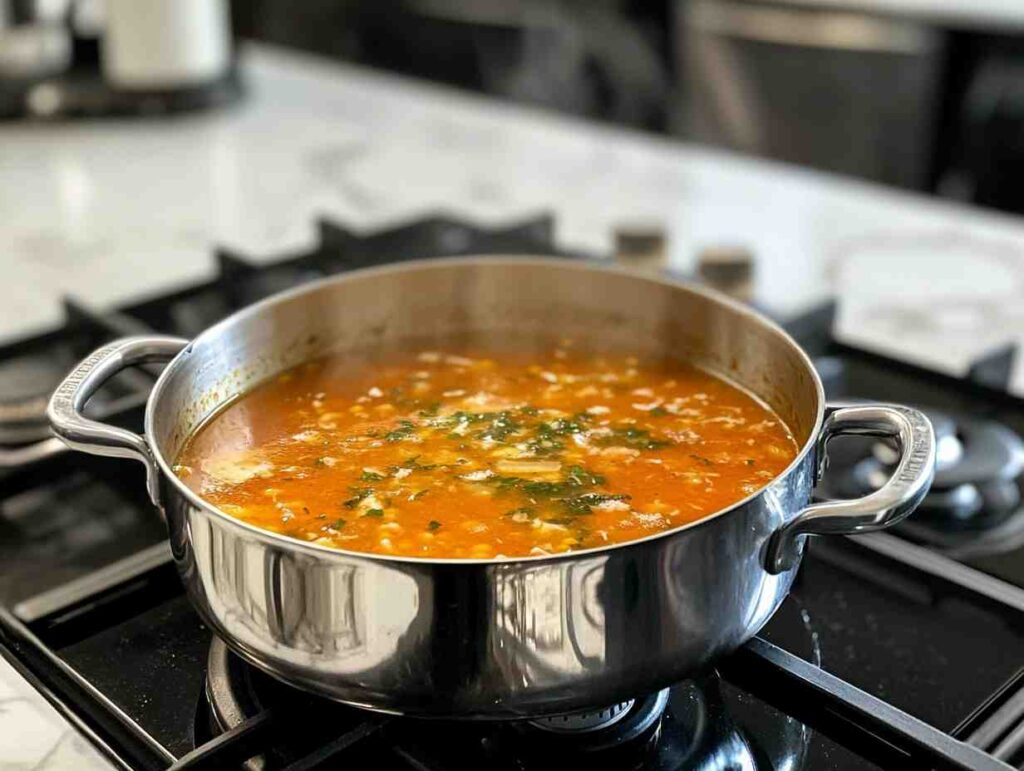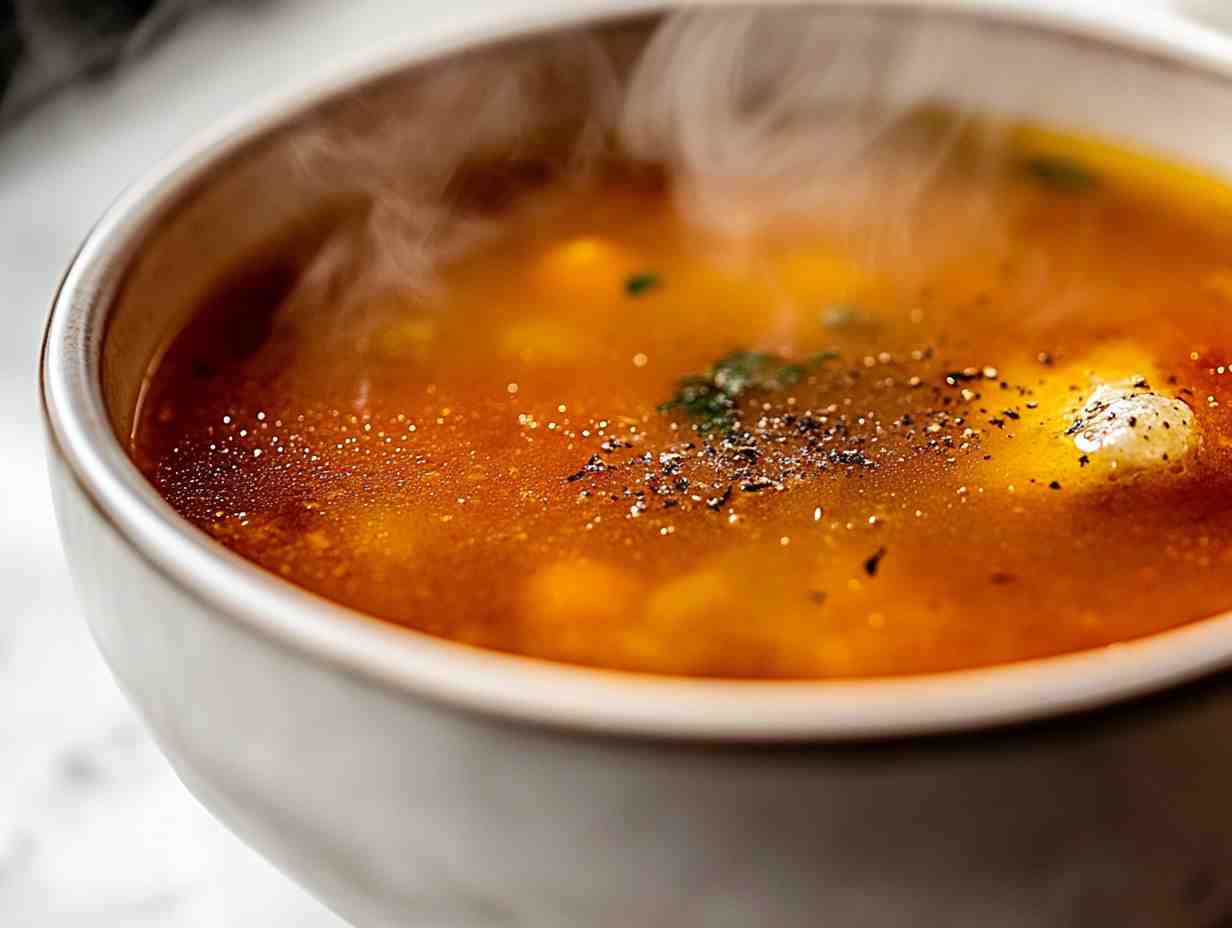Have you ever wondered what happens to the parmesan rind in soup? Many home cooks throw away the parmesan rind, unaware of the secret flavor it holds. However, this seemingly useless piece can add a significant depth of flavor to your soups and broths. This article explores all the benefits and uses of parmesan rind when cooking. We will delve into how it enhances your recipes. Therefore, you’ll learn how to use it effectively.
The Secret Life of the Parmesan Rind: Why Keep It?
Many people are used to tossing out the parmesan rind. They may think it is just too hard to eat. However, this is actually a treasure trove of flavor. The rind, the hard outer layer of the parmesan cheese, is full of concentrated cheesy flavor. Therefore, it is perfect for infusing into soups. It releases a savory, salty, and umami-rich taste as it simmers. In addition, it will enrich the whole dish. Therefore, you will see that it is a very valuable ingredient for all kinds of soups.
What Exactly Is a Parmesan Rind and Where Does it Come From?
Before delving into its culinary uses, let’s explore what a parmesan rind is. The parmesan rind is the hard, outer layer of a wheel of Parmigiano-Reggiano cheese. Furthermore, this layer develops during the aging process. It is not meant to be eaten directly in its solid state. Therefore, the purpose of the parmesan rind is to protect the cheese. But it also contains a wealth of flavor.
Flavor Enhancement of Parmesan Rind in Soup
So, what happens to the parmesan rind in soup? As the rind simmers, it slowly releases its intense flavor into the liquid. This process adds a deeper, more complex taste to the broth. Furthermore, it also introduces a salty and umami profile. Therefore, it elevates the overall taste of the dish. Additionally, the parmesan rind enriches the soup’s texture. Thus, it contributes to a richer mouthfeel.
How to Use Parmesan Rind in Soup for Maximum Flavor

Here are some guidelines to use parmesan rind in your soups and broths:
- Add it Early: Drop the parmesan rind into the pot at the beginning of your cooking process. Furthermore, this allows it to simmer for a longer time. In addition, it allows for the optimal release of flavor.
- Simmer Gently: Do not boil the rind too vigorously. Therefore, a gentle simmer is better. Furthermore, this prevents the rind from becoming overly tough. Additionally, it also allows for a slow release of flavor.
- Remove Before Serving: The parmesan rind will soften, but it will remain tough. Therefore, remove it from the soup before serving. Furthermore, you should discard it after it has done its job.
- Don’t Overdo It: One or two small parmesan rinds is often enough for a pot of soup. In addition, using too many can make the soup too salty or overpowering.
Types of Soups that Benefit Most From Parmesan Rind
While a parmesan rind can enhance many types of soups, certain varieties benefit the most. Here are some examples:
- Vegetable Soups: It adds depth and complexity to simple vegetable broths.
- Tomato-Based Soups: It enhances the acidity of the tomatoes. Therefore, it creates a more savory dish.
- Bean Soups: The salty, cheesy flavor pairs well with the earthiness of beans.
- Minestrone: It’s a traditional ingredient in Italian minestrone, adding a hearty flavor.
- Broths and Stocks: It’s great for creating rich and flavorful base stocks.
Practical Tips for Parmesan Rind Use in Broths and Stews
Beyond soup, you can also use a parmesan rind to flavor broths and stews. These practical tips will guide you:
- Freezing Rinds: Store rinds in the freezer until you are ready to use them. For example, place them in an airtight container. In addition, freezing ensures their long-term preservation.
- Cutting Rinds: Cut large rinds into smaller pieces for easier use in soups. This also helps for more efficient flavor release.
- Broth Infusion: Add rinds to any homemade broth. Also, it adds layers of flavor.
- Slow Cooker Magic: Include rinds in slow cooker recipes for a longer, more flavorful infusion.
The Transformation of Parmesan Rind: What Changes?

When you add a parmesan rind to soup, its texture and structure changes. While it won’t melt completely, it will soften and become pliable. Here is what happens to the parmesan rind in soup at a chemical level:
- Protein Breakdown: The proteins in the rind slowly break down during simmering.
- Fat Release: The rind’s fats leach into the broth. Therefore, this will enhance both flavor and richness.
- Flavor Extraction: The prolonged exposure to heat allows flavor compounds to fully emerge.
- Texture Change: The rind’s hard outer layer softens, which facilitates further flavor extraction.
The Science Behind Parmesan Rind’s Flavor Release
Understanding the science behind parmesan rind flavor is key. The rind contains a high concentration of glutamates. These are molecules that provide umami flavor. Heat helps these compounds to release into the soup. Furthermore, simmering allows for a gradual and even flavor dispersion. Therefore, the longer the rind simmers, the more flavor it provides. The process is a chemical reaction.
Storing and Preparing Parmesan Rinds
To make the most of your parmesan rinds, proper storage is essential:
- Refrigeration: Fresh parmesan rinds can be stored in an airtight container in the fridge. For instance, wrap them tightly in plastic.
- Freezing: For long-term storage, freeze the rinds. In addition, place them in freezer-safe bags.
- Rinsing: Rinse off any visible debris before adding the rind to your soup.
- Size Matters: Large rinds can be cut into smaller, manageable pieces. Furthermore, this makes them easier to use.
Parmesan Rind: An Underrated Flavor Enhancer
The parmesan rind is an underrated ingredient. It adds a depth of flavor that few other ingredients can provide. What happens to the parmesan rind in soup is a wonderful transformation. It changes a simple broth into something special. Therefore, you should start saving your parmesan rinds today. In addition, they can be a valuable addition to any kitchen.
Other Creative Ways to Use Parmesan Rinds in Cooking
Apart from soups, there are several other ways to use parmesan rinds in your cooking:
- Infused Oils: Add rinds to olive oil to create a flavorful infusion.
- Sauces: Drop them into tomato sauces for a richer, more complex flavor.
- Risotto: Add a rind while simmering risotto for an extra layer of cheesy taste.
- Polenta: Enhance polenta by simmering rinds in the cooking liquid.
- Roasting Vegetables: Place them in the roasting pan with vegetables for added flavor.
The Sustainability Aspect of Using Parmesan Rinds
Using parmesan rinds is not just about flavor. It is also a sustainable practice that can reduce food waste. Instead of discarding a potentially useful ingredient, you are making the most of your purchase. Furthermore, this is a great way to make your kitchen more sustainable.
- Reducing Waste: It helps cut down on kitchen waste.
- Resourcefulness: It’s a great example of resourcefulness. Therefore, it allows you to maximize your ingredients.
- Eco-Friendly: It promotes a more environmentally conscious way of cooking.
Why Parmesan Rind is a Pantry Staple for the Savvy Cook
A parmesan rind is more than just a leftover. It’s a secret weapon for any savvy cook. Its ability to enhance flavors without adding fats or extra salt makes it invaluable. Therefore, it is an ideal ingredient for those seeking deep flavors. Moreover, it’s also a key for cooking healthier. So, instead of throwing them away, start making the most of this versatile ingredient.
Parmesan Rind vs. Other Cheese Rinds
While parmesan rinds are very popular for cooking, you might wonder if you can use other types of cheese rinds as well. Here’s a quick comparison:
- Pecorino Rinds: Similar to parmesan rinds, they can add a strong, salty flavor to dishes. However, they can also be slightly more pungent.
- Grana Padano Rinds: These rinds are a bit milder than parmesan, therefore they are good for a delicate flavor.
- Other Hard Cheese Rinds: Most hard cheese rinds can be used. However, it is important to note the flavor profile before using them.
- Soft Cheese Rinds: Soft cheese rinds are not generally recommended. Moreover, they may not hold up well during cooking.
A Deep Dive into the Flavor Profile of Parmesan Rind
Let’s dig a bit deeper into the flavor profile of the parmesan rind. It is known for:
- Umami: A rich, savory taste that is key to enhancing the flavor of soups.
- Saltiness: It adds a salty touch that complements other flavors.
- Nuttiness: A subtle nutty flavor that develops during aging.
- Tanginess: A slight tang that comes from the fermentation process.
- Depth: A complexity that is not found in other ingredients.
Making the Most of Your Parmesan Rind Collection
If you regularly use parmesan, you will soon find yourself with a collection of parmesan rinds. Here are some tips for managing and using them:
- Labeling: Label your freezer bags with the date to keep track of older rinds.
- Rotating Stock: Use the oldest rinds first to ensure freshness.
- Variety: Mix different types of rinds for a more complex flavor.
- Experiment: Try using different quantities of rinds to discover your perfect flavor balance.
Troubleshooting Common Issues with Parmesan Rind Use
Even with all the information available, you may have questions or encounter issues with using parmesan rinds. Here’s how to address them:
- Too Salty Soup: This may mean using too much parmesan rind in a single batch. Therefore, use less next time.
- Rind is Too Tough: Ensure you are simmering gently, not boiling, to avoid toughness. Also, remember to remove the rind before serving.
- Rind Doesn’t Release Flavor: Make sure that the rind is submerged completely in the liquid. Furthermore, simmer for a good length of time.
- Flavor is Too Weak: This may mean that the rind was not fresh enough. Therefore, store them properly, and use them in a timely manner.
The Cultural Significance of Parmesan Rind in Cooking
The use of parmesan rinds in cooking is deeply rooted in cultural tradition. In Italian cuisine, it is a common practice to use all parts of an ingredient. Therefore, the parmesan rind is not wasted. This reflects a commitment to resourcefulness and flavor. In addition, this approach to cooking is very sustainable.
Elevating Your Soup Game: The Parmesan Rind Secret
By incorporating parmesan rinds into your cooking, you are not just adding flavor. You’re embracing a more conscious and efficient way of cooking. Furthermore, you’ll reduce waste, and add complexity to your meals. Therefore, the next time you enjoy parmesan cheese, don’t discard that valuable parmesan rind. Instead, use it in your next soup and transform your cooking. You will finally understand what happens to the parmesan rind in soup.
In conclusion, parmesan rinds are a wonderful and often overlooked addition to the kitchen. Their ability to infuse dishes with rich flavor makes them indispensable. Using them is a testament to resourcefulness. Therefore, it will improve your culinary endeavors.

